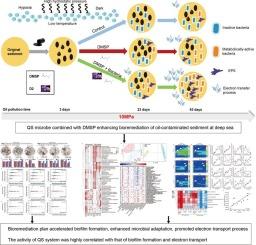群体感应微生物与二甲基磺酰丙酸盐联合增强典型深海条件下石油污染沉积物生物修复的新见解:性能和分子机制
IF 4.9
3区 环境科学与生态学
Q1 ENVIRONMENTAL SCIENCES
引用次数: 0
摘要
深海环境给微生物带来了巨大的代谢挑战,使得石油污染的生物修复更加艰巨。群体感应(Quorum sensing, QS)信号有助于微生物群在有毒污染物下维持其功能和稳定性。二甲基磺丙酸酯(DMSP)是一种理想的低温保护剂和应激保护剂,可增强微生物在极端环境下的恢复能力。基于此,本研究在深海微观环境下对QS细菌和DMSP在石油污染沉积物修复中的应用进行了为期2个月的综合研究。首先,分离出一株与DMSP共存的QS信号产生菌。结果表明,该菌与DMSP联合处理后,对污染沉积物的除油效果较好,降解率比对照提高约40%。通过对具有超活性和代谢活性的微生物的检测和生化实验,这种联合作用的分子生态机制与以下几个方面有关:1)加速了生物膜的形成,表现为涉及蛋白质和脂质生物合成、细菌分泌系统和细胞运动的高表达途径,增加了细胞外聚合物物质的产生;2)微生物适应能力增强,表现为群落网络更加复杂,DNA修复和转录相关通路表达活性上调;3)促进了电子传递过程,表现为细胞色素c等在细胞呼吸途径中的表达增加。综上所述,我们的研究结果为QS系统在实际深海石油污染沉积物修复中的应用提供了有价值的理论指导和实证支持。本文章由计算机程序翻译,如有差异,请以英文原文为准。

Novel insights into quorum-sensing microbe combined with dimethylsulfoniopropionate enhancing bioremediation of oil-contaminated sediment under typical deep-sea conditions: The performances and molecular mechanisms
The deep-sea environment poses significant metabolic challenges to microorganisms, rendering the bioremediation of oil pollution even more formidable. Quorum sensing (QS) signals are known to assist microbiota in maintaining their function and stability under toxic contaminants. Dimethylsulfoniopropionate (DMSP) is an ideal cryoprotectant and stress protectant, enhancing microbial resilience in extreme environments. Given these, the comprehensive investigations on the application of QS bacteria and DMSP in restoring oil-polluted sediment were conducted at deep-sea microcosm over two months. First, a strain of QS signals-producing bacteria coexisting with DMSP was isolated. Then, a high-efficiency oil elimination was observed in polluted sediment treated by the bacteria jointly with DMSP, with a degradation rate about 40 % higher than the control. Via detection of meta- and metabolically-active microbes and biochemical experiment, the molecular-ecological mechanisms of such combination were associated with the following aspects: 1) the expedited biofilm formation, as evidenced by the hyper-expressive pathways involving proteins and lipid biosynthesis, bacterial secretory system and cell motility, as well as the increasing production of extracellular polymeric substances; 2) the improved microbial adaptation, as shown by more complex community network and upregulated expressing activity of pathways related to DNA repair and transcription; 3) the facilitated electron transport process, as exhibited by the increased expression in cell-respiratory pathways of such as cytochrome c. Overall, our results offer valuable theoretical guidance and empirical support for the application of QS system in remediation of oil-polluted sediment at real deep sea.
求助全文
通过发布文献求助,成功后即可免费获取论文全文。
去求助
来源期刊

Marine pollution bulletin
环境科学-海洋与淡水生物学
CiteScore
10.20
自引率
15.50%
发文量
1077
审稿时长
68 days
期刊介绍:
Marine Pollution Bulletin is concerned with the rational use of maritime and marine resources in estuaries, the seas and oceans, as well as with documenting marine pollution and introducing new forms of measurement and analysis. A wide range of topics are discussed as news, comment, reviews and research reports, not only on effluent disposal and pollution control, but also on the management, economic aspects and protection of the marine environment in general.
 求助内容:
求助内容: 应助结果提醒方式:
应助结果提醒方式:


